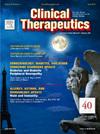韩国队列研究中负荷剂量依从性和长期抗vegf持久性对糖尿病黄斑水肿结局的影响
IF 3.6
4区 医学
Q2 PHARMACOLOGY & PHARMACY
引用次数: 0
摘要
目的:评价坚持初始负荷剂量(LD)和持续1年抗血管内皮生长因子(anti-VEGF)治疗对糖尿病黄斑水肿(DME)治疗失败的影响。方法:本回顾性队列研究纳入了2017年至2021年间接受玻璃体内抗vegf注射治疗DME的患者。在索引日期前一年内既往接受过抗vegf治疗或替代治疗的患者被排除在外。LD依从性定义为在治疗开始的63天内完成三次注射。治疗失败定义为在索引日期后首次出现替代治疗。采用多变量Cox比例风险模型。结果:在2239例患者中,抗vegf治疗在1年、2年和3年的持续率分别为45.2%、24.1%和16.8%。75.5%的患者有依从性。与LD粘附组相比,LD不完全组治疗失败的风险明显更高(HR = 1.91;95% ci: 1.06-3.43)。然而,将LD间隔延长至180天对治疗失败没有显著影响(HR = 1.04, 95% CI: 0.59-1.83;P = 0.90)。在第一年内停止治疗的患者在三年后治疗失败的风险增加1.62倍(HR = 1.62;95% ci: 1.01-2.60)。意义:坚持初始LD和持续抗vegf治疗对于降低DME患者治疗失败风险至关重要。重要的是,与标准LD计划的轻微偏差,间隔延长至180天,可能不会对治疗失败产生不利影响。这些发现强调了在个性化安排灵活性的同时提高患者依从性的策略的必要性。本文章由计算机程序翻译,如有差异,请以英文原文为准。
Impact of Loading Dose Adherence and Long-term Anti-VEGF Persistence on Diabetic Macular Edema Outcomes in a Korean Cohort Study
Purpose
To evaluate the impact of adherence to the initial loading dose (LD) and 1-year persistence of anti-vascular endothelial growth factor (anti-VEGF) therapy on treatment failure in diabetic macular edema (DME).
Methods
This retrospective cohort study included patients receiving intravitreal anti-VEGF injections for DME between 2017 and 2021. Patients with prior anti-VEGF treatments or alternative therapies within one year before the index date were excluded. LD adherence was defined as completing three injections within 63 days of treatment initiation. Treatment failure was defined as the first occurrence of alternative treatments post-index date. Multivariable Cox proportional hazards models were performed.
Findings
Among 2,239 patients, the persistence rates of anti-VEGF therapy were 45.2%, 24.1%, and 16.8% at 1, 2, and 3 years, respectively. LD adherence was observed in 75.5% of patients. Compared to the LD adherent group, the LD incomplete group had a significantly higher risk of treatment failure (HR = 1.91; 95% CI: 1.06–3.43). However, extending the LD interval up to 180 days did not significantly impact treatment failure (HR = 1.04, 95% CI: 0.59–1.83; P = 0.90). Patients who discontinued treatment within the first year exhibited a 1.62-fold higher risk of treatment failure at three years (HR = 1.62; 95% CI: 1.01–2.60).
Implications
Adherence to the initial LD and sustained anti-VEGF therapy are crucial for reducing treatment failure risk in DME patients. Importantly, minor deviations from the standard LD schedule, with intervals extending to 180 days, may not adversely affect the treatment failure. These findings highlight the need for strategies to enhance patient adherence while individualized scheduling flexibility.
求助全文
通过发布文献求助,成功后即可免费获取论文全文。
去求助
来源期刊

Clinical therapeutics
医学-药学
CiteScore
6.00
自引率
3.10%
发文量
154
审稿时长
9 weeks
期刊介绍:
Clinical Therapeutics provides peer-reviewed, rapid publication of recent developments in drug and other therapies as well as in diagnostics, pharmacoeconomics, health policy, treatment outcomes, and innovations in drug and biologics research. In addition Clinical Therapeutics features updates on specific topics collated by expert Topic Editors. Clinical Therapeutics is read by a large international audience of scientists and clinicians in a variety of research, academic, and clinical practice settings. Articles are indexed by all major biomedical abstracting databases.
 求助内容:
求助内容: 应助结果提醒方式:
应助结果提醒方式:


